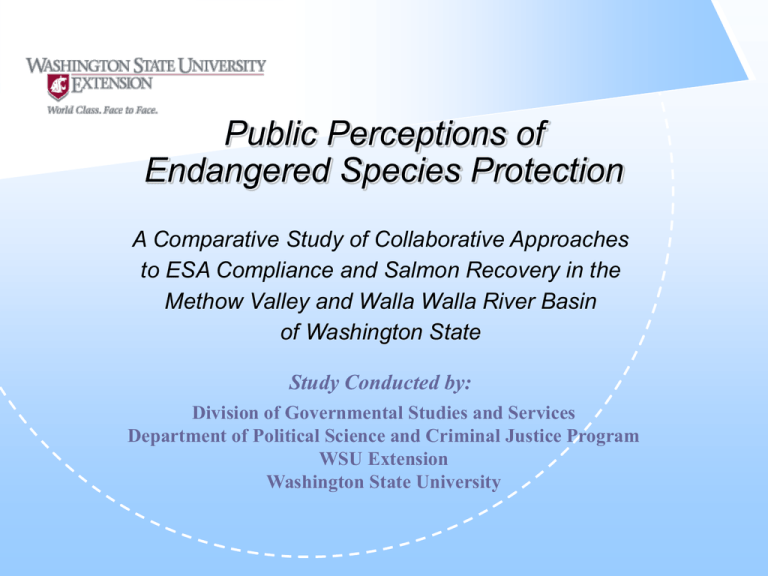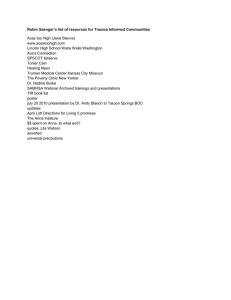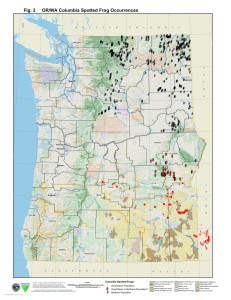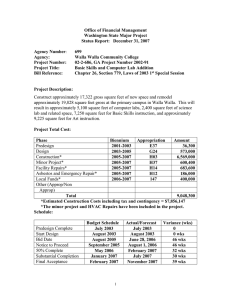Michael J. Gaffney
advertisement

Public Perceptions of Endangered Species Protection A Comparative Study of Collaborative Approaches to ESA Compliance and Salmon Recovery in the Methow Valley and Walla Walla River Basin of Washington State Study Conducted by: Division of Governmental Studies and Services Department of Political Science and Criminal Justice Program WSU Extension Washington State University Study Commissioned and Funded by: Office of Law Enforcement National Marine Fisheries Service National Oceanic and Atmospheric Administration “NOAA Fisheries” U.S. Department of Commerce Study Goals Determine if Community Oriented Policing and Problem Solving (COPPS) is a viable approach for addressing ESA and natural resource protection issues. Can Federal and State resource regulatory agencies collaborate effectively with each other and the public to achieve successful outcomes for resource protection? Can collaborative approaches achieve resource protection goals? Are collaborative approaches capable of providing both short term and long term resource protection benefits? Can non-traditional resource protection efforts be measured accurately and effectively? Projects Studied Methow River Walla Walla River Comparison of Issues Methow • “Threatened” Listing • Bull Trout (1998) • “Endangered” Listings • Steelhead (1997) • Chinook (1999) • • • • Fish Screens Flow Regimes Passage Federal Nexus Present Walla Walla • “Threatened” Listings • Bull Trout (1998) • Steelhead (1999) • • • • Fish Screens Flow Regimes Passage Federal Nexus Present Study Focus • Are Collaborative Approaches to Resource Protection Effective? • Evaluate public perceptions of collaborative problem solving for natural resource issues • What lessons can be learned from collaborative attempts in the Methow Valley and Walla Walla Basin? • How can these results be used to enhance natural resource protection efforts? Study Methodologies Surveys: Written Instruments – Congruent Questions WDFW and NMFSMethow 19, Walla Walla 11 1800 Randomly Selected Citizens Each Methow 800+, Walla Walla 900+ Key Actor Interviews: Methow 20+, Walla Walla 20+ “Snowball” Interview Process Typical Reported Perceptions • Walla Walla: “The Salmon Recovery Effort is fine as long as society as a whole is willing to pay for the costs associated with whatever fixes are determined necessary.” • Methow: “Stuff the salmon up your ass. Ag comes first.” Important Factors • • • • Area Specific Conditions Community Character Agency Characteristics Reputation Entrepreneurial Leadership Process Issues Consistency Inclusivity Area Specific Issues Methow Walla Walla Opportunity for Creative Compromise Yes, constrained by Yes Endangered Listing Sensitivity to Values Some High Firm Deadlines Yes No Educational Outreach Limited, Poor Extensive Attention to Social & Political Realities Little to None Extensive Entrepreneurial Leadership Weak Strong Community Character • • Methow Low overall Social Capital High in a few Enclaves Walla Walla High overall Social Capital High in multiple Enclaves Agency Characteristics: Reputation -- Methow Agency Prior to Effort During Effort WDFW •Moderate Trust •Strong, generally positive •Same, but NMFS in (Secondary) NMFS (Primary) community relations •Strong reputation for working w/communities •Low trust – Mistrust •Weak, negative community relations •Strong reputation for “command and control” approach, not working w/communities driver’s seat •No benefit – Credit by association •Mistrust magnified by mixed messages and dominant signaling •Command and control preferred strategy Agency Characteristics: Reputation – Walla Walla Agency Prior to Effort During Effort WDFW •Moderate Trust •Strong, generally positive •Moves to high trust •Clear, consistent signal community relations •Strong reputation for working w/communities favoring collaboration •Entrepreneurial leadership •Low trust – Mistrust – •Recedes into background, Methow example injects fear •Weak, but Not negative community relations •C-and C reputation same as Methow yet still positive bump to moderate level of trust •Benefit – Credit by Association (Primary) NMFS (Secondary) Agency Characteristics: Entrepreneurial Leadership • Methow --Lack of/weak --Several people from NMFS are “face” of agencies --Lack of clear commitment by leaders to collaborative, win-win solutions --Primary message is one of coercion (“you’re going to do this no matter what”) and threats (to viability of livelihoods) --Behavior reflects little to no interest in crafting trust-based relationships • Walla Walla --Strong --One key leader from WDFW is “face” of agencies --Displays clear commitment to collaborative, win-win solutions --Behavior exhibits strong commitment to crafting trust-based relationships Process Issues • • • • No Formal Rules in Either Case Both Processes Inclusive Number of Screens ≈ Success Breakdown in Methow Quantitative Findings – Part 1 • Demographic Factors Functionally Equal • Gender • Age • Education • Family Income • Occupation Quantitative Findings – Part 1 • Demographic Factors Functionally Equal • Gender • Age • Education • Family Income • Occupation Quantitative Findings – Part 1 • Demographic Factors Functionally Equal • Gender • Age • Education • Family Income • Occupation Quantitative Findings – Part 1 • Demographic Factors Functionally Equal • Gender • Age • Education • Family Income • Occupation Quantitative Findings – Part 1 • Demographic Factors Functionally Equal • Gender • Age • Education • Family Income • Occupation Quantitative Findings – Part 2 • Environmental & Political Values • • • • Environmental Attitudes Fiscal Policy Orientation Social Policy Orientation Partisan Affiliation Environmental Attitudes • In Response To Four Attitude Statements Using... • Dunlap “Environmental Paradigm” Scale “Plants and animals are primarily for human use” “Mankind was created to rule over nature” “Humans have an ethical obligation to protect plants and animals” “The Earth should have far fewer people on it” Fiscal and Social Policy Orientation Partisan Affiliation General Outlook On Life: A Critical Difference? • How would you describe your general outlook on life with regards to people being trustworthy and honest? Quantitative Findings – Part 3 • Key Survey Elements • • • • Levels of Trust Support for ESA Good Faith Bargaining Achieving Acceptable Outcomes Comparison of Trust Levels • How much trust do you have in the information provided by the major actors involved in the process of developing an agreement for salmon recovery under the ESA? Support For ESA • How has your observation of the collaborative process regarding salmon recovery affected your support for the ESA? Methow Walla Walla 3.1% 10.3% Level of support DID NOT CHANGE 24.3% 56.0% Made me LESS supportive of ESA 72.6% 33.6% Made me MORE supportive of ESA Good Faith Bargaining • What is your impression of the “Good Faith* Bargaining” exhibited by the major actors involved in the salmon recovery process? Acceptable Outcomes • Does A Collaborative Process for Salmon Recovery Lead to Outcomes Acceptable to All Parties? Methow Walla Walla HAS NOT WORKED ~ SHOULD NOT WORK 66.0% 24.3% HAS NOT WORKED ~ MIGHT WORK 21.6% 22.4% HAS WORKED ~ UNLIKELY TO WORK 3.6% 10.4% HAS WORKED ~ SHOULD WORK 8.8% 42.9% Principal Observations • Methow Valley Collaborative approach had minimal success Very little public support generated for ESA Issue became highly polarized politically Low social capital (trust) a negative factor Compliance achieved, but at high social cost Principal Observations • Walla Walla River Basin Collaborative approach had major success Significant public support generated for ESA Issue never became polarized locally High social capital (trust) a positive factor Compliance achieved on major scale Lessons Learned Creating a Bargaining Space The B(W)ATNA Equation • Agency Approach – Influence on Others’ Willingness to Collaborate BATNA = Best Alternative To a Negotiated Agreement Bargaining Space No Enforcement Threat No Alternatives to Enforcement Principal Findings • Collaborative approaches, including COPPS derivatives, can be successful in providing resource protection. • Success is generally dependent upon several key factors Initial approach and timing is vital Policy and process must be consistent Collaboration must occur among major actors Long term success is dependent upon short term approach Social capital (trust) may be of critical importance • Roles for Extension Professionals/Educators • • • • Process Expert Advisor to Convener/Group Subject Matter Expertise Training/Education Leadership Skills for the 21st Century ~ Meeting the Challenge ~ Mission Statement “The Natural Resources Leadership Academy will serve as a forum through which participants may acquire the knowledge, skills, and tools necessary to develop effective citizen-to-government relationships based upon respect, trust, and inclusivity to foster broadly supported and effective natural resource stewardship.” Program Objective Provide State-of-the-Art Training … Resource Regulatory Professionals Community Oriented Approaches Interest Based Problem Solving Collaborative Partnerships Build Trust and Respect Program Emphasis Four Basic Curriculum Categories Leadership Stewardship Problem Solving Communication Contact Information: Michael J. Gaffney, J.D., Acting Director Division of Governmental Studies and Services, Washington State University PO Box 4870 Pullman, WA 99164-4870 (509) 335-3329 mjgaffney@wsu.edu





